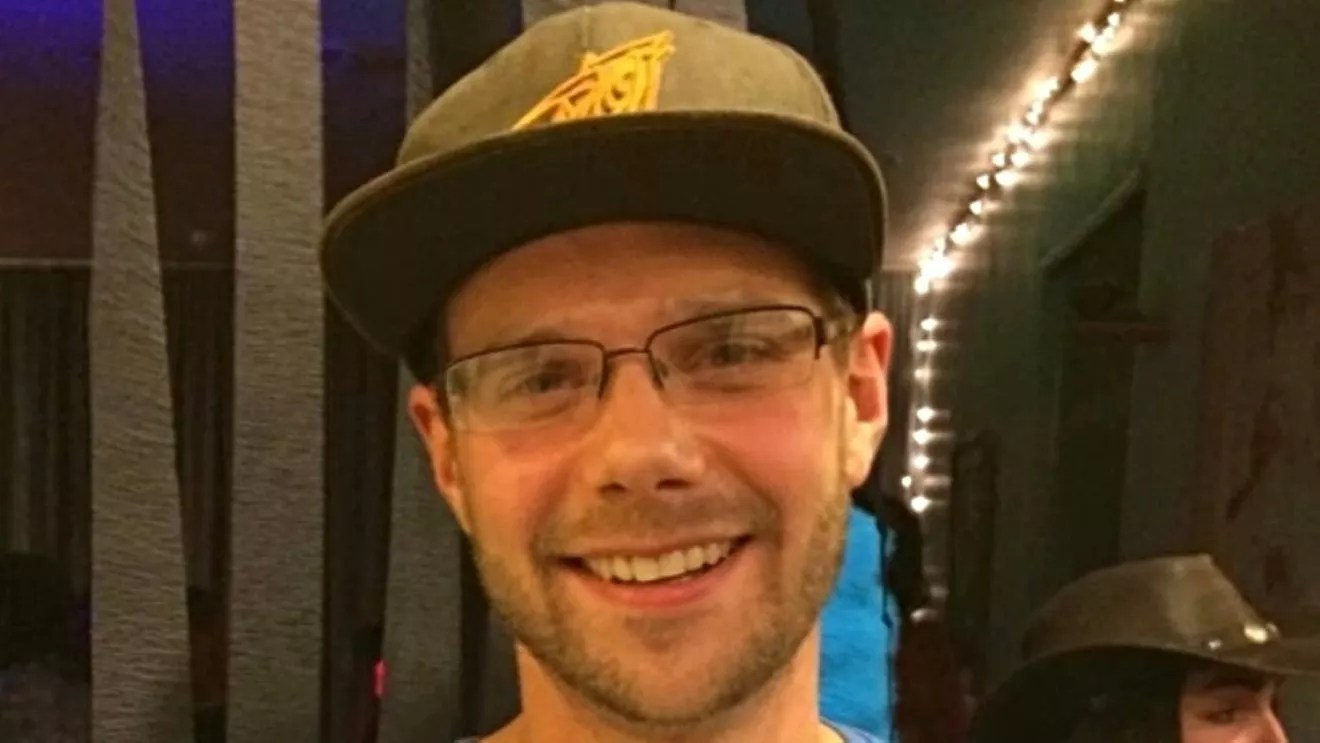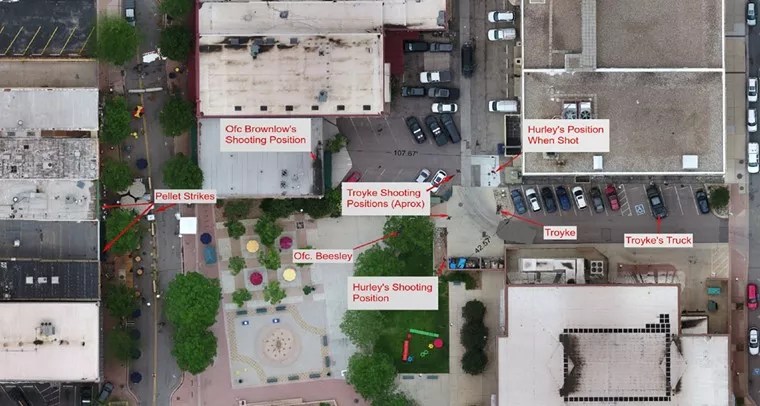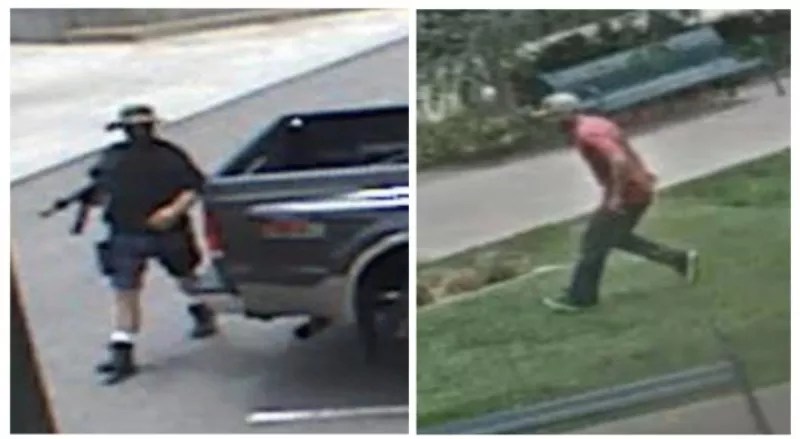
Family photo

Audio By Carbonatix
On June 21, 2021, a gunman later identified as Ronald Troyke mounted an attack in Olde Town Arvada during which he murdered Gordon Beesley, a beloved officer with the Arvada Police Department. Johnny Hurley, who happened to be shopping for camping supplies at the nearby Army Navy Surplus Store when shots rang out, subsequently killed Troyke, only to then be slain by another APD officer, Kraig Brownlow.
In November, First Judicial District DA Alexis King announced that no criminal charges would be pressed against Brownlow after tragically taking the life of Hurley, who’d been hailed as a hero by the department. And on June 22, Johnny’s mother, Kathleen Boleyn, joined by his estate, filed a lawsuit against Brownlow, who has resigned from the force, and Arvada Police Chief Link Strate for her son’s death a year and a day earlier.
Boleyn admits that the decision to sue wasn’t easy, particularly given the praise that the APD has showered on her son. “I was pleased that they referred to him as a hero, and he literally was one,” she says. “He put his life on the line to save others – and even though those others were strangers, he met the call and did what needed to be done. But the reason I’m filing suit is that while Johnny did what the police were supposed to do, he shouldn’t have had to die because of it.”
In its response to the complaint, the City of Arvada stresses that “based on the District Attorney’s findings and after an internal review, the APD found that Officer Brownlow’s actions were consistent with APD policy and procedures.”
But according to Crist Whitney, part of the legal team from Denver-based Rathod Mohamedbhai LLC working on Boleyn’s behalf, that’s precisely why Strate was named as a defendant. “Under Chief Strate’s leadership, Arvada initiated and enacted policies that just weren’t lawful and trained officers to shoot first and ask questions afterward during active shooter incidents,” Whitney says. “It was these policies that led to Officer Brownlow’s unlawful use of force against Johnny.”

An aerial view of the shooting site, with the locations of key individuals labeled.
According to the section of DA King’s decision letter labeled “Facts Established Through Investigation,” on June 21, Brownlow, along with officers Sterling Boom and Michael Hall, was working as part of the police department’s Community Outreach Resource and Enforcement, or CORE, unit. Their office, an APD substation, was located in a small office building that faces west toward Olde Wadsworth, with an east entrance consisting of “a metal door with a window on the top half and a COVID protocol sign centered on the glass.” The ground outside the door “slopes downward to the east and allows for visibility through the rear library parking lot all the way to Webster Street on the east side of the block.”
The day started off slowly, with the officers catching up on paperwork. But they were also strapped: Each sported a handgun and a standard-duty tool belt; Brownlow’s weapon is described as a Glock 34 with a seventeen-round magazine and a bullet in the chamber.
Just before 1:30 p.m., the trio heard “three loud bangs,” followed by “another series of bangs” that prompted them to look out the window of the east door. Boom quickly spotted “a man carrying an AR-15 black carbine-style rifle with a long magazine, dressed in black, wearing an old-style ski mask and a black, floppy hat”: Troyke. But Boom didn’t immediately engage the suspect, the DA’s letter noted, since he was about forty yards away and feared that “if he fired and missed, the man with the AR-15 would start shooting at the east door and down the narrow hallway,” endangering Hall and Brownlow, who had taken cover at his urging.
Boom subsequently radioed that “the man in black” appeared to be about to enter a gray truck at the end of the nearby parking lot, but he then started walking back toward the CORE office and the Olde Town Arvada square. Boom told Brownlow and Hall to keep an eye on the gunman while he ran to the west side of the building in the hope of ambushing him, the account continues. But the plan was short-circuited by the locked west door, which Boom was unable to use as an exit.
Meanwhile, Hall heard a third round of shots as Brownlow stood at the east door “with his weapon drawn and pointed at the window.” At that point, Hall lost sight of Troyke, but soon spotted “a man with a red shirt” (Hurley) holding a handgun and a rifle. After Hurley paused in place, it looked to Brownlow that he “was either reloading the rifle or trying to fix something while holstering his pistol,” the letter continued.
Brownlow, who reportedly feared that a second gunman was working in conjunction with the man in black, responded by firing three rounds at Hurley, who was struck in the pelvis. The wound proved fatal.
DA King began the “analysis” section of the decision letter by noting that “Officer Brownlow had a unique and limited vantage point from which to make his decision to shoot John Hurley. In a span of less than three minutes, Brownlow learned the following: A man dressed in black stalked Olde Town Arvada, on a warm summer day when the square and surrounding businesses and services were busy with folks getting lunch, playing in the square, and visiting the library. Officer Brownlow observed the man in black carrying an AR-style rifle similar to those used by mass shooters. Critically, Brownlow reasonably believed that the man in
black was firing the weapon repeatedly, having heard at least three series of gunshots in or near the popular Olde Town square.”
Shortly thereafter, King continued, Hurley came into view, carrying “a similar rifle as the man in black, as well as an additional handgun,” and he “looked intent on fixing or loading the rifle.” Hurley’s pause “gave an opportunity to law enforcement that the man in black had not – John Hurley was still, highly visible, with a wall of bricks behind him. If Officer Brownlow engaged before John Hurley had a chance to fix or reload his rifle or turn his attention on the lesser-armed Brownlow, Brownlow would fire towards a safe backdrop that would not jeopardize others.”
In King’s view, these factors served as justification for Brownlow’s choice to shoot, despite Hurley’s “heroic actions that day.” But the lawsuit contends that “Officer Brownlow had no reason to believe there was a second active shooter, nor did he consider that possibility until after he shot Mr. Hurley.”
Whitney describes the second-shooter storyline as “an after-the-fact rationalization” – and he also dismisses the possibility that Brownlow could have mistaken Hurley for Troyke.

The lawsuit argues that a reasonable officer couldn’t have mistaken gunman Ronald Troyke, left, for Johnny Hurley, right, on the day of the shooting.
Arvada Police Department via Rathod Mohamedbhai LLC
“If you look at the pictures and the videos, you’ll see the gunman was wearing black – a black hat, black T-shirt, black shorts, black boots – whereas Johnny was wearing a red shirt and he had blue jeans on,” he says. “So not only did they have different clothing, but they had very different builds and different ways of moving. A reasonable officer wouldn’t have confused them, and anyone who’s looking at the pictures or the videos wouldn’t have confused them. They are two distinct individuals.”
The lawsuit draws a sharp contrast between the choices made by Hurley, noting that “he drew a concealed-carry pistol, ran toward the active shooter and stopped the threat,” and the behavior of Brownlow, Hall and Boom. “Unlike Mr. Hurley, the three APD officers did not spring into action,” it notes. “Rather, they cowered inside, choosing self-preservation over defense of the civilian population.”
Whitney stands behind this language: “The facts speak for themselves. Regardless of what words are used, these three officers were inside the building, and as soon as Johnny heard the shot, he left the store he was in, moved across the square, found a spot where he could take on the shooter, and he took him out – and the officers were inside, watching. They said they were outgunned, because the shooter had a rifle and they had handguns. But that was the same situation with Johnny. The shooter had a rifle, whereas Johnny just had a handgun.”
He adds: “It takes a certain type of person to put himself in that kind of situation, and Johnny was that type of person. The officers didn’t respond the same way Johnny did. Those are just the facts.”
Videos established that Brownlow watched Hurley for eleven seconds before opening fire – and he did so without warning.
“Officer Brownlow had been watching the scene from inside the administration building,” Whitney says. “He saw the gunman, and then John came through and took down the gunman. The whole situation was now safe for Officer Brownlow to come out of the building, and when he did, he saw Johnny, and Johnny had his back to him as he was unloading the weapon – taking the magazine out of the gunman’s rifle while simultaneously attempting to holster his own pistol. During this whole time, Johnny was stationary; he was hunched over and the rifle was pointed down.”
At that point, Whitney says, “All Officer Brownlow had to do, if he was assuming that this was the shooter, was to say something – because Johnny wasn’t a threat. He was unloading the weapon, which witnesses saw him doing. But instead of giving any kind of command, he fired and hit Johnny from behind. There was no imminent threat, and he was clearly not the gunman Officer Brownlow had seen. He had eleven seconds – more than enough time to think, ‘This is a different person’ and give a command. But that didn’t happen.”
The lack of a heads-up from Brownlow also troubles Boleyn. Her son had experience with firearms, and she says he knew that “if you have someone who is down, you have to retrieve their weapon, because they might not be dead. If he’d had any idea police were present, he would have laid down the weapon and raised his hands. The fact that the police didn’t announce themselves, didn’t even give him a chance – that’s wrong.”
She sees what Hurley did on his final day as “in alignment with his other activism: helping the less fortunate, participating in things like Community Sharefest, and helping people who just needed a hand.”
Hurley was “a compassionate person even when he was a toddler,” she says. “He was just an amiable guy who made friends easily. He had the gift of gab, he enjoyed intelligent discourse, and did a lot of different outdoor activities. He was an adventurer – and there had been other situations where he reached out and helped others in dire circumstances.”
The lawsuit is Boleyn’s attempt to prevent a repeat of what happened to Hurley. “If the police aren’t held accountable, then we will be grieving with other mothers who’ve lost their sons in the same situation,” she explains. “Everyone thinks their child is special, and I thought Johnny was, too. He was a happy guy, he had a lot of friends, he had compassion. A light has been taken from the world, and a lot of people have been affected by this. The citizens of Arvada lost their innocent that day, and many strangers are thankful to Johnny because they were in the square and the shooter could have come back. They were all afraid of being shot.”
Boleyn declines to share her opinion about the decision not to criminally charge Brownlow, but says that “what Johnny did was what they should have done. I thought the police signed up to run toward the action, and they let Johnny do that for them.”
Over the past year, “I’ve done pretty well moving through the grief process,” Boleyn says. “I have found that there’s a level of sadness that’s a little closer to the surface than it used to be. It’s harder to watch the news, and I cry more easily at sad events. I’m not sure if there is ever closure completely. But I’ve also found that in the face of grief, I’ve found pride. I’m so proud of what Johnny did – and I’m stronger than I thought I was.”
Click to read Estate of John Hurley, et al., v. Kraig Brownlow, et al, and the John Hurley shooting decision letter. Here’s the City of Arvada’s response to the lawsuit:
Statement from the City of Arvada regarding the lawsuit filed by the Estate of John “Johnny” Hurley
The City of Arvada is aware of the lawsuit filed against Arvada Police Department (APD) members, which was previously announced to the media by the Law Firm of Rathod Mohamedbhai.We would remind the public that the First Judicial District Attorney’s Office thoroughly reviewed the facts in this case after an independent investigation by the First Judicial District Critical Incident Response Team (CIRT). In November 2021, District Attorney Alexis King found that APD Officer Kraig Brownlow’s actions were both reasonable and justified under the circumstances.
Based on the District Attorney’s findings and after an internal review, the APD found that Officer Brownlow’s actions were consistent with APD policy and procedures. The APD is not considering changes to its actual training or response protocols at this time.
After the District Attorney announced her findings, Officer Brownlow resigned from the APD in good standing.
The events of June 21, 2021 were caused by Ronald Troyke, an individual that harbored an unfounded hatred toward police officers. When civil litigation is announced by a plaintiff’s attorney in a manner that mischaracterizes and omits select information, it has the potential to compromise officer safety.
We stand by every member of the APD. We are confident that any mischaracterizations will be resolved in court.